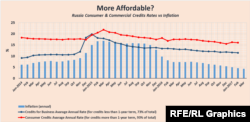Medvedev’s comment is more wishful thinking than reality. Indeed, for the first three months of 2017, according to the Central Bank of Russia, the volume of bank credit decreased by 2.1 percent. While loans to non-financial companies were down 3.1 percent consumer loans crept up 0.6 percent.
The gap reflects a trend in 2016 (GRAPH 1) when the Russian loan market sunk 6.9 percent due to a collapse in business borrowing and weak growth in new consumer credit.
After loans to businesses and industry skyrocketed by 12.7 percent in 2015 , they crashed by 9.5 percent in 2016. The opposite thing happened with the consumer loan market. After falling by 5.7 percent in 2015, consumer loans were up 1.1 percent in 2016.
Moreover, the number of bad loans (defined by the Bank of Russia as loans more than 90 days overdue) began to creep up again. The share of such delinquent loans from businesses increased from 6.3 in December to 7.1 percent in March; the share of overdue consumer credit rose from 7.9 to 8.1 percent, a year after dipping by the same amount.
Tellingly, more than half of all consumer loans issued in 2016 were not to pay for new consumption, but to pay off old loans. Lending rates, while remaining high, (GRAPH 2) dipped down just enough to make loan refinancing attractive for many Russians. And banks did all in their power to convince their costumers to do this.
According to data from the United Credit Bureau, (UCB) -- one of the three biggest credit unions in Russia -- 53 percent of private borrowers saddled themselves with new loans explicitly to pay off previous debt.
Overall, only 19 percent of new credit issued by Russian banks in 2016 went to new lenders (with no credit history) while the rest went to borrowers already paying off at least one loan. Those saddled with at least two loans represented 30 percent of those taking on new credit in Russia in 2016; 18 percent had three; 9 percent four; 10 percent five.
The percentage of Russians taking on their first consumer loan is likely to decrease further, predicts Yury Gribanov, director of the Russian analytical firm, Frank Research Group. The reason is simple: the Russian credit market is reaching its saturation point.
By early 2017, all the active bank loans in Russia were in the hands of more than 60 percent of the working-age population. Nonetheless, the general Russian consumer debt load is not relatively high, according to the UCB. A “normal” debt load, note UCB experts, is a ratio of income to debt payment of between 30-35 percent. This ratio dropped from 37 percent in 2015 to 33 percent in 2016 in Russia. The average monthly debt repayment by Russian private borrowers decreased from 12,700 rubles in 2015 to 12,100 rubles in 2016. That’s about a third of the 2016 average monthly nominal wage of 36,746 rubles, or about $613 at exchange rates on January 1, 2017.
The prospects for a resurgent credit market in Russia in 2017 look bleak. According to analysis from Russia’s Analytical Credit Rating Agency, the demand for fresh consumer credit will likely be limited by anticipated falling real incomes. And given the gloomy outlook for the economy as a whole, little if any growth is expected in the corporate loan sector as well.
Should such predictions prove correct, even a more accessible credit market, which Medvedev hails, will not likely lead to a significant increase in lending in the country. Only a few companies and enterprises are likely to take on new debt, while for a significant part of the population, already struggling now with debt, taking on new loans will make little sense.







